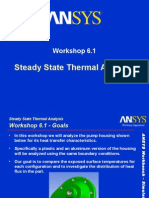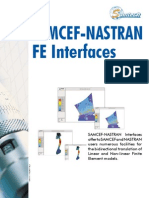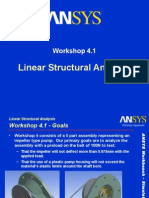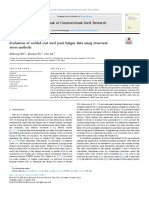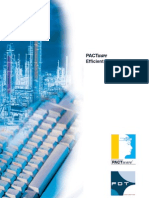Transient Thermal Analysis: Workshop 6.2
Transient Thermal Analysis: Workshop 6.2
Uploaded by
TA Dinh XuanCopyright:
Available Formats
Transient Thermal Analysis: Workshop 6.2
Transient Thermal Analysis: Workshop 6.2
Uploaded by
TA Dinh XuanOriginal Description:
Original Title
Copyright
Available Formats
Share this document
Did you find this document useful?
Is this content inappropriate?
Copyright:
Available Formats
Transient Thermal Analysis: Workshop 6.2
Transient Thermal Analysis: Workshop 6.2
Uploaded by
TA Dinh XuanCopyright:
Available Formats
Workshop 6.
Transient Thermal Analysis
Transient Thermal Analysis
Workshop 6.2 - Goals
Workshop Supplement
ANSYS Workbench - Simulation ANSYS Workbench - Simulation - Simulation - Simulation
In this workshop, we will analyze the electrically heated base typical of consumer steam irons like the one shown below.
August 26, 2005 Inventory #002266 WS6.2-2
Transient Thermal Analysis
Workshop 6.2 - Assumptions
Assumptions: The heating element contacts and transfers heat to the base using the pattern shown here Upon initial startup a heat flux of 0.001 W/mm2 is applied until a steady state is reached Heating follows a 30 second step cycle of 0 to 0.003 W/mm2 after steady state is reached The analysis will begin with the steady state solution and proceed through the cyclic loading described above
Workshop Supplement
August 26, 2005 Inventory #002266 WS6.2-3
ANSYS Workbench - Simulation ANSYS Workbench - Simulation - Simulation - Simulation
Transient Thermal Analysis
Workshop 6.2 - Start Page
From the launcher start Simulation. Choose Geometry > From File . . . and browse to the file Iron.x_t.
Workshop Supplement
ANSYS Workbench - Simulation ANSYS Workbench - Simulation - Simulation - Simulation
When DS starts, close the Template menu by clicking the X in the corner of the window.
August 26, 2005 Inventory #002266 WS6.2-4
Transient Thermal Analysis
Workshop 6.2 - Preprocessing
Change the part material to Polyethylene:
1. Highlight Part1 2. In the Detail window Material field Import . . . 3. Choose material Stainless Steel 2 1
Workshop Supplement
ANSYS Workbench - Simulation ANSYS Workbench - Simulation - Simulation - Simulation
3 4 4. Set the working units to (mm, kg, N, C, s, mV, mA) Tools > Units menu choose
August 26, 2005 Inventory #002266 WS6.2-5
Transient Thermal Analysis
Workshop 6.2 - Environment
5. Select surface representing the heating element on the face of the iron 5
Workshop Supplement
ANSYS Workbench - Simulation ANSYS Workbench - Simulation - Simulation - Simulation
6. RMB > Insert > Heat Flux.
7. Set Magnitude field to 0.001 W/mm2
August 26, 2005 Inventory #002266 WS6.2-6
Transient Thermal Analysis
. . . Workshop 6.2 - Environment
8. Select the bottom surface (opposite the heat flux side) and 6 side surfaces of the iron (7 faces) RMB > Insert > Convection
Workshop Supplement
ANSYS Workbench - Simulation ANSYS Workbench - Simulation - Simulation - Simulation
9.
10. Change to Temperature Dependent
9 12 10
11. Choose Import in the correlation field 12. Select Stagnant Air Vertical Planes1 13. Set ambient temperature to 20 deg. C
11 13
August 26, 2005 Inventory #002266 WS6.2-7
Transient Thermal Analysis
. . . Workshop 6.2 - Environment
14. Select the 2 surfaces surrounding the heated surface 15. RMB > Insert > Convection 16. Change to Temperature Dependent
Workshop Supplement
ANSYS Workbench - Simulation ANSYS Workbench - Simulation - Simulation - Simulation
14
15 16 18
17. Choose Import in the correlation field 18. Select Stagnant Air Vertical Planes 19. Set ambient temperature to 40 deg. C
17
August 26, 2005 Inventory #002266 WS6.2-8
Transient Thermal Analysis
Workshop 6.2 - Solution
Add temperature and total heat flux results. 20. Highlight the Solution branch. 21. RMB > Insert > Thermal > Temperature, repeat for total heat flux 20
Workshop Supplement
ANSYS Workbench - Simulation ANSYS Workbench - Simulation - Simulation - Simulation
21 22. Solve 22
August 26, 2005 Inventory #002266 WS6.2-9
Transient Thermal Analysis
Workshop 6.2 - Results
A review of the results shows the maximum steady state temperature is approximately 51.7 degrees C The worksheet view of the environment shows that an energy balance has been achieved
Convection1 + Convection2 5.2 W Applied Load = 0.001W/mm2 * Area
Area 5276 mm
Workshop Supplement
ANSYS Workbench - Simulation ANSYS Workbench - Simulation - Simulation - Simulation
August 26, 2005 Inventory #002266 WS6.2-10
Transient Thermal Analysis
Workshop 6.2 Transient Solution
23. Highlight the Temperature result, RMB > Generate Transient Environment with Initial Condition
Workshop Supplement
ANSYS Workbench - Simulation ANSYS Workbench - Simulation - Simulation - Simulation
23
The result is, the steady state environment is duplicated and the new branch automatically setup as a thermal transient run
Notice the new branch contains an initial condition branch and a transient settings branch
August 26, 2005 Inventory #002266 WS6.2-11
Transient Thermal Analysis
Workshop 6.2 Transient Setup
24. Begin the transient setup by specifying an end time of 180 seconds for the analysis in the toolbar
Workshop Supplement
ANSYS Workbench - Simulation ANSYS Workbench - Simulation - Simulation - Simulation
24
25. Inspection of the initial condition details shows no action is required. The steady state (non-uniform) temperature result from the Environment branch is mapped to the transient branch
25
August 26, 2005 Inventory #002266 WS6.2-12
Transient Thermal Analysis
. . . Workshop 6.2 - Transient Setup
26. Highlight Heat Flux in the Thermal Transient branch
Workshop Supplement
ANSYS Workbench - Simulation ANSYS Workbench - Simulation - Simulation - Simulation
26
27. In the heat flux detail change Define As to Load History 28. In the History Data field choose New Load History . . .
27 28
August 26, 2005 Inventory #002266 WS6.2-13
Transient Thermal Analysis
. . . Workshop 6.2 - Transient Setup
The Engineering Data application will open and a new Heat Flux vs. Time chart/graph will be created Enter the time and load data as shown on the next page
Workshop Supplement
August 26, 2005 Inventory #002266 WS6.2-14
ANSYS Workbench - Simulation ANSYS Workbench - Simulation - Simulation - Simulation
Transient Thermal Analysis
. . . Workshop 6.2 - Transient Setup
29. Enter time and load information as described in the problem statement
30 second increments 0.003 W/mm2 Heat Flux
Workshop Supplement
ANSYS Workbench - Simulation ANSYS Workbench - Simulation - Simulation - Simulation
29
August 26, 2005 Inventory #002266 WS6.2-15
Transient Thermal Analysis
. . . Workshop 6.2 - Transient Setup
30. Highlight the Transient Settings branch
Workshop Supplement
ANSYS Workbench - Simulation ANSYS Workbench - Simulation - Simulation - Simulation
31. Toggle off all items but Heat Flux in the Visible and Active columns of the Timeline Legend Control
30
Notice the automatic time steps are based on the end time: Initial = ET/100, Min = ET/1000, Max = ET/10 Leave time steps as default
31
August 26, 2005 Inventory #002266 WS6.2-16
Transient Thermal Analysis
. . . Workshop 6.2 - Transient Setup
Workshop Supplement
ANSYS Workbench - Simulation ANSYS Workbench - Simulation - Simulation - Simulation
Toggling off all but the heat flux allows easier inspection of the timeline chart in this case Since the heat flux is the only load defined as a non-constant it will have the only influence on the placement of the automatic step resets Reset points
As expected, each reset point coincides with an inflection point on the load history
August 26, 2005 Inventory #002266 WS6.2-17
Transient Thermal Analysis
Workshop 6.2 - Transient Results
32. Solve the thermal transient branch
Workshop Supplement
ANSYS Workbench - Simulation ANSYS Workbench - Simulation - Simulation - Simulation
32
When the solution is complete, results can be reviewed just as with steady state solutions
33. Highlight the quantity of interest to plot
33
31
August 26, 2005 Inventory #002266 WS6.2-18
Transient Thermal Analysis
. . . Workshop 6.2 - Transient Results
Workshop Supplement
ANSYS Workbench - Simulation ANSYS Workbench - Simulation - Simulation - Simulation
34. To review results from specific time points, LMB in the timeline chart to locate the time of interest 35. RMB > Retrieve Results
34 35
August 26, 2005 Inventory #002266 WS6.2-19
Transient Thermal Analysis
. . . Workshop 6.2 - Transient Results
Notice, when a new time point is selected in the time line, the result detail is displayed in red until the results matching the time selection are retrieved
Workshop Supplement
ANSYS Workbench - Simulation ANSYS Workbench - Simulation - Simulation - Simulation
Plotting the Global Maximum temperature from the Solution Information branch shows the model has not reached a cyclic equilibrium
August 26, 2005 Inventory #002266 WS6.2-20
Transient Thermal Analysis
. . . Workshop 6.2 - Transient Results
Using the Probe Tool allows individual parts of the model to be evaluated over time Multiple Probes can be plotted on the same graph
Workshop Supplement
Single Probe
Multiple Probes
August 26, 2005 Inventory #002266 WS6.2-21
ANSYS Workbench - Simulation ANSYS Workbench - Simulation - Simulation - Simulation
You might also like
- A User-Material Subroutine Incorporating Single Crystal Plasticity in The Abaqus Finite Element ProgramNo ratings yetA User-Material Subroutine Incorporating Single Crystal Plasticity in The Abaqus Finite Element Program47 pages
- VR Integrated Heritage Recreation - Using Blender and Unreal Engine 4100% (1)VR Integrated Heritage Recreation - Using Blender and Unreal Engine 4336 pages
- Finite Element Simulation of Conventional and High Speed Machining of Ti6Al4V AlloyNo ratings yetFinite Element Simulation of Conventional and High Speed Machining of Ti6Al4V Alloy9 pages
- Steady State Thermal Analysis: Workshop 6.1No ratings yetSteady State Thermal Analysis: Workshop 6.118 pages
- Designxplorer Parameter Manager: Workshop 9No ratings yetDesignxplorer Parameter Manager: Workshop 920 pages
- Advanced Results Processing: Workshop 8No ratings yetAdvanced Results Processing: Workshop 826 pages
- Comparing 2D and 3D Structural Analysis: Workshop 4.2No ratings yetComparing 2D and 3D Structural Analysis: Workshop 4.234 pages
- Mechanical Intro 14.5 WSAppB SubmodelingNo ratings yetMechanical Intro 14.5 WSAppB Submodeling19 pages
- Using The ACT Console For Automation in Mechanical: We Make Innovation WorkNo ratings yetUsing The ACT Console For Automation in Mechanical: We Make Innovation Work26 pages
- NCodeDL Intro 17.0 L01 Lecture Slides Fatigue IntroductionNo ratings yetNCodeDL Intro 17.0 L01 Lecture Slides Fatigue Introduction28 pages
- 1972-Large Deformation Isotropic Elasticity - On The Correlation of Theory and Experiment - Ogden100% (1)1972-Large Deformation Isotropic Elasticity - On The Correlation of Theory and Experiment - Ogden21 pages
- Mechanical Nonlin 13.0 WS 05A PlasticityNo ratings yetMechanical Nonlin 13.0 WS 05A Plasticity26 pages
- Constructional Viscoelastic Composite Materials Theory and ApplicationNo ratings yetConstructional Viscoelastic Composite Materials Theory and Application170 pages
- Chapter 3: Shell Meshing: Checking and Editing MeshNo ratings yetChapter 3: Shell Meshing: Checking and Editing Mesh12 pages
- Abaqus Tutorial 29 Interference SimuleonNo ratings yetAbaqus Tutorial 29 Interference Simuleon9 pages
- Linear Structural Analysis: Workshop 4.1No ratings yetLinear Structural Analysis: Workshop 4.124 pages
- Ansys Capabilities Chart 2020 r1 v2 PDFNo ratings yetAnsys Capabilities Chart 2020 r1 v2 PDF59 pages
- Chapter Overview: in This Chapter, Performing Linear Static Structural Analyses in Simulation Will Be CoveredNo ratings yetChapter Overview: in This Chapter, Performing Linear Static Structural Analyses in Simulation Will Be Covered53 pages
- Bending Strength of Gear Teeth by Cantilever-Plate TheoryNo ratings yetBending Strength of Gear Teeth by Cantilever-Plate Theory8 pages
- ANSYS Finite Element Analysis Coordinate SystemNo ratings yetANSYS Finite Element Analysis Coordinate System12 pages
- Evaluation of Welded Cast Steel Joint Fatigue Data Using Structural Stress MethodsNo ratings yetEvaluation of Welded Cast Steel Joint Fatigue Data Using Structural Stress Methods15 pages
- Scalar and Vectorized User Defined Material Routines in LS-DYNA100% (1)Scalar and Vectorized User Defined Material Routines in LS-DYNA52 pages
- Mech Nonlin Connections 14.5 L02 Interface TreatmentsNo ratings yetMech Nonlin Connections 14.5 L02 Interface Treatments32 pages
- Abaqus Tutorial 30 - Chain - Stab - SimuleonNo ratings yetAbaqus Tutorial 30 - Chain - Stab - Simuleon10 pages
- Transient Analysis: ANSYS Mechanical Linear and Nonlinear DynamicsNo ratings yetTransient Analysis: ANSYS Mechanical Linear and Nonlinear Dynamics56 pages
- Damage Mechanics in Metal Forming: Advanced Modeling and Numerical SimulationFrom EverandDamage Mechanics in Metal Forming: Advanced Modeling and Numerical Simulation4/5 (1)
- Ai Tipi Axisymmetric Pipe With Fins: Workshop 12 Thermal AnalysisNo ratings yetAi Tipi Axisymmetric Pipe With Fins: Workshop 12 Thermal Analysis14 pages
- Workshop 01.2: Heating Coil: ANSYS Mechanical Heat TransferNo ratings yetWorkshop 01.2: Heating Coil: ANSYS Mechanical Heat Transfer11 pages
- Lats Hvac User's Manual: LG ElectronicsNo ratings yetLats Hvac User's Manual: LG Electronics57 pages
- A Review of Pedestrian Group Dynamics AnNo ratings yetA Review of Pedestrian Group Dynamics An13 pages
- The Leadership Quarterly: George C. Banks, Shelley D. Dionne, Hiroki Sayama, Marianne Schmid MastNo ratings yetThe Leadership Quarterly: George C. Banks, Shelley D. Dionne, Hiroki Sayama, Marianne Schmid Mast2 pages
- Systematic Evaluation of Single-Use Systems Using Process Simulation Tools - A Case Study Involving Mab ProductionNo ratings yetSystematic Evaluation of Single-Use Systems Using Process Simulation Tools - A Case Study Involving Mab Production13 pages
- Walking Simulation Model of Lower Limb Exoskeleton Robot Design100% (1)Walking Simulation Model of Lower Limb Exoskeleton Robot Design11 pages
- Simulation and Optimisation of Lift Networks in A Provincial Skiing ResortNo ratings yetSimulation and Optimisation of Lift Networks in A Provincial Skiing Resort6 pages
- Transforming Traditional Teaching Laboratories For Effective Remote Delivery-A ReviewNo ratings yetTransforming Traditional Teaching Laboratories For Effective Remote Delivery-A Review9 pages
- Design and Implementation Mobile Arduino PDFNo ratings yetDesign and Implementation Mobile Arduino PDF244 pages
- A Method For Root Cause Analysis With A Bayesian Belief Network and Fuzzy Cognitive Map PDFNo ratings yetA Method For Root Cause Analysis With A Bayesian Belief Network and Fuzzy Cognitive Map PDF20 pages
- Impulse Voltage Generation Using MATLAB/Simulink and Its Integration in Undergraduate High Voltage Engineering CourseNo ratings yetImpulse Voltage Generation Using MATLAB/Simulink and Its Integration in Undergraduate High Voltage Engineering Course6 pages
- Module 1 - Basic Concepts of Educational TechnologyNo ratings yetModule 1 - Basic Concepts of Educational Technology17 pages
- Inaudi - Salt Cavern Monitoring System For Early Detection of Sinkhole FormationNo ratings yetInaudi - Salt Cavern Monitoring System For Early Detection of Sinkhole Formation4 pages
- Ware Ware Ware Ware Ware: Efficient ConfigurationNo ratings yetWare Ware Ware Ware Ware: Efficient Configuration8 pages
- Digital Twin Paradigm: A Systematic Literature Review: Concetta Semeraro, Mario Lezoche, Hervé Panetto, Michele DassistiNo ratings yetDigital Twin Paradigm: A Systematic Literature Review: Concetta Semeraro, Mario Lezoche, Hervé Panetto, Michele Dassisti43 pages
- A User-Material Subroutine Incorporating Single Crystal Plasticity in The Abaqus Finite Element ProgramA User-Material Subroutine Incorporating Single Crystal Plasticity in The Abaqus Finite Element Program
- VR Integrated Heritage Recreation - Using Blender and Unreal Engine 4VR Integrated Heritage Recreation - Using Blender and Unreal Engine 4
- Finite Element Simulation of Conventional and High Speed Machining of Ti6Al4V AlloyFinite Element Simulation of Conventional and High Speed Machining of Ti6Al4V Alloy
- Comparing 2D and 3D Structural Analysis: Workshop 4.2Comparing 2D and 3D Structural Analysis: Workshop 4.2
- Using The ACT Console For Automation in Mechanical: We Make Innovation WorkUsing The ACT Console For Automation in Mechanical: We Make Innovation Work
- NCodeDL Intro 17.0 L01 Lecture Slides Fatigue IntroductionNCodeDL Intro 17.0 L01 Lecture Slides Fatigue Introduction
- 1972-Large Deformation Isotropic Elasticity - On The Correlation of Theory and Experiment - Ogden1972-Large Deformation Isotropic Elasticity - On The Correlation of Theory and Experiment - Ogden
- Constructional Viscoelastic Composite Materials Theory and ApplicationConstructional Viscoelastic Composite Materials Theory and Application
- Chapter 3: Shell Meshing: Checking and Editing MeshChapter 3: Shell Meshing: Checking and Editing Mesh
- Chapter Overview: in This Chapter, Performing Linear Static Structural Analyses in Simulation Will Be CoveredChapter Overview: in This Chapter, Performing Linear Static Structural Analyses in Simulation Will Be Covered
- Bending Strength of Gear Teeth by Cantilever-Plate TheoryBending Strength of Gear Teeth by Cantilever-Plate Theory
- Evaluation of Welded Cast Steel Joint Fatigue Data Using Structural Stress MethodsEvaluation of Welded Cast Steel Joint Fatigue Data Using Structural Stress Methods
- Scalar and Vectorized User Defined Material Routines in LS-DYNAScalar and Vectorized User Defined Material Routines in LS-DYNA
- Mech Nonlin Connections 14.5 L02 Interface TreatmentsMech Nonlin Connections 14.5 L02 Interface Treatments
- Transient Analysis: ANSYS Mechanical Linear and Nonlinear DynamicsTransient Analysis: ANSYS Mechanical Linear and Nonlinear Dynamics
- Damage Mechanics in Metal Forming: Advanced Modeling and Numerical SimulationFrom EverandDamage Mechanics in Metal Forming: Advanced Modeling and Numerical Simulation
- Ai Tipi Axisymmetric Pipe With Fins: Workshop 12 Thermal AnalysisAi Tipi Axisymmetric Pipe With Fins: Workshop 12 Thermal Analysis
- Workshop 01.2: Heating Coil: ANSYS Mechanical Heat TransferWorkshop 01.2: Heating Coil: ANSYS Mechanical Heat Transfer
- The Leadership Quarterly: George C. Banks, Shelley D. Dionne, Hiroki Sayama, Marianne Schmid MastThe Leadership Quarterly: George C. Banks, Shelley D. Dionne, Hiroki Sayama, Marianne Schmid Mast
- Systematic Evaluation of Single-Use Systems Using Process Simulation Tools - A Case Study Involving Mab ProductionSystematic Evaluation of Single-Use Systems Using Process Simulation Tools - A Case Study Involving Mab Production
- Walking Simulation Model of Lower Limb Exoskeleton Robot DesignWalking Simulation Model of Lower Limb Exoskeleton Robot Design
- Simulation and Optimisation of Lift Networks in A Provincial Skiing ResortSimulation and Optimisation of Lift Networks in A Provincial Skiing Resort
- Transforming Traditional Teaching Laboratories For Effective Remote Delivery-A ReviewTransforming Traditional Teaching Laboratories For Effective Remote Delivery-A Review
- A Method For Root Cause Analysis With A Bayesian Belief Network and Fuzzy Cognitive Map PDFA Method For Root Cause Analysis With A Bayesian Belief Network and Fuzzy Cognitive Map PDF
- Impulse Voltage Generation Using MATLAB/Simulink and Its Integration in Undergraduate High Voltage Engineering CourseImpulse Voltage Generation Using MATLAB/Simulink and Its Integration in Undergraduate High Voltage Engineering Course
- Module 1 - Basic Concepts of Educational TechnologyModule 1 - Basic Concepts of Educational Technology
- Inaudi - Salt Cavern Monitoring System For Early Detection of Sinkhole FormationInaudi - Salt Cavern Monitoring System For Early Detection of Sinkhole Formation
- Digital Twin Paradigm: A Systematic Literature Review: Concetta Semeraro, Mario Lezoche, Hervé Panetto, Michele DassistiDigital Twin Paradigm: A Systematic Literature Review: Concetta Semeraro, Mario Lezoche, Hervé Panetto, Michele Dassisti






